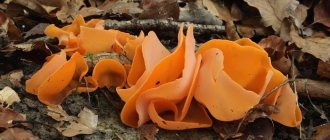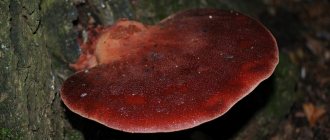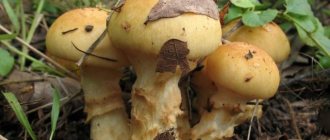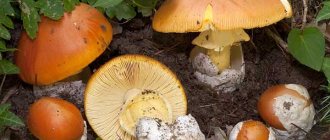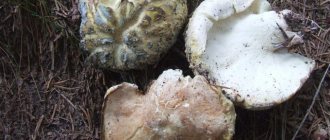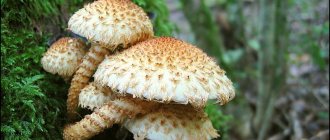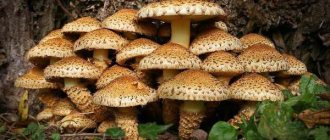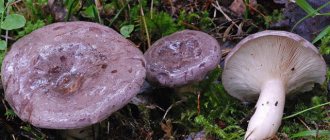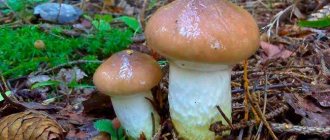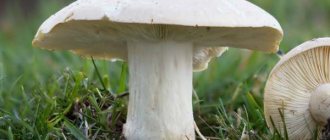Description of golden flake
Golden scale, or royal honey fungus (as well as Pholiota aurivella, willow, thick or greasy scale) looks really luxurious: a large bell-shaped cap covers a thin stalk with tiny scales. The size of the mushroom is 10 - 15 cm in height, but as it grows, the cap of the golden scale reaches a truly royal size - up to 20 cm and, unlike many poisonous analogues, does not change shape as its size increases.
Description of the cap
The cap of the young mushroom is bell-shaped, 5–6 cm in diameter, yellow in color with various shades of sand or rust. On top it is covered with small flake-like scales of a darker color than the color of the cap. During further growth, the cap straightens and takes on the shape of a wide bell. The lamellar hymenophore is hidden behind a white veil in young individuals; subsequently the veil is torn, leaving only a light felt fringe along the edge of the cap. As it grows, the dark scales on the cap become less noticeable.
Description of the leg
The leg of the golden scale is up to 10 cm long, up to 1.5 cm in diameter, yellowish-brown in color, completely covered with felt scales of a darker color, as clearly demonstrated in the photo of the mushroom. In young representatives there is a ring on the leg, formed from a rupture. In adults there is no ring.
Features of growth
The scale often bears fruit abundantly from July to September. Under comfortable climate conditions, there are cases when the mushroom began to be collected in May. In color and appearance, honey mushrooms and common scaly mushrooms are vaguely similar. Some mushroom pickers confuse them. In the autumn, honey mushrooms become scaly-like.
The difference between these two mushrooms is manifested in the absence of scales in honey mushrooms. Also, their flesh is not hard. This property of the mushroom must be paid attention to when collecting. Also, flakes do not have poisonous imitators. There is no need to fear that a mushroom brought in a basket that matches its description will be poisonous.
Scale is a parasitic fungus. It penetrates with its roots under the bark, drawing out vital juices from the plant. Over time, the tree begins to gradually die. As the mycelium develops, it cuts more and more into the trunk. Most often, the scale selects for growth weak trees that are unable to resist its destructive effects. It is in such places that you can collect a large number of mushrooms. Since this type of scale grows abundantly on the selected tree or stump, collecting it will not be difficult.
Is golden flake edible or not?
Royal honey fungus belongs to the fourth category of mushrooms, which is designated as having minimal value from a gastronomic point of view. However, it is not only edible, but also beneficial for human health, as it has medicinal properties. The mushroom pulp has a somewhat specific taste, which is easily eliminated after a short soaking for 2 - 4 hours. When properly prepared, the taste of royal mushrooms is quite high. However, before any kind of cooking, they must be boiled.
Important! In the West, golden flake is not considered a valuable food product, but in China and Japan it is widely consumed not only for gastronomic, but also for medicinal purposes.
Emergency care for mushroom poisoning
- Gastric lavage. At home, you should drink water and induce vomiting by pressing on the root of the tongue. In a hospital, this procedure is carried out using a probe.
- Cleansing enema. It is given if more than two hours have passed since the poisoning.
- Reception of adsorbents. Activated carbon, Enterosgel and other drugs will help bind toxins and neutralize them.
- Drinking salted water or drugs whose action is aimed at combating dehydration. Drink water in small sips, often. The drugs are taken according to the instructions. When the vomiting stops, the patient can be given strong, sweet tea.
- Wrapping up. The victim must be warmed up. Hypothermia may occur due to severe dehydration. Warm blankets, heating pads and complete rest are the first things to do when vomiting and diarrhea stop.
Information sources
- All about mushrooms / Ed.-comp. N. G. Lebedeva. — Kharkov: Relikt, 1997
- Noordeloos, ME
Flora agaricina Neerlandica. — 1999
How to cook golden flake
Main courses and marinated preparations are prepared from golden flakes, but only after first boiling the mushrooms for 15-20 minutes. They taste great with meat, potatoes and vegetables. Suitable for preparing stews, fillings for pies and assorted mushrooms. Mushrooms are prepared for the winter table in various ways:
- dried;
- salt;
- pickled.
Stewed dishes from royal honey mushrooms with the addition of milk or sour cream have high taste.
How to pickle golden flakes
Marinating golden flake is the most popular way of cooking it. At home, you can prepare canned food that will not be inferior in taste to store-bought.
The algorithm of actions is as follows:
- Mushrooms are cleaned, sorted by size, washed thoroughly and boiled in salted water for 20 - 25 minutes.
- Place in a colander and allow the water to drain.
- Place in prepared, pre-sterilized jars.
- Add cloves, bay leaves, peppercorns, peeled garlic cloves.
- Prepare the marinade: add 2 tbsp to 1 liter of water. l. sugar, 2.5 tbsp. l. non-iodized salt. After boiling, add table vinegar - 4 - 5 tbsp. l.
- The marinade is poured over the prepared flakes and immediately rolled into jars.
Important! You should not overdo it with spices: they overshadow the mushroom taste and aroma.
How to fry golden flakes with onions
Preparing the easiest and at the same time delicious dish from golden flakes will not take much time, but will provide invaluable benefits to the body. Cooking algorithm:
- Mushrooms brought from the forest are cleaned, washed and boiled in salted water for 20 - 25 minutes.
- The mushroom mass is placed in a colander, the water is allowed to drain completely and placed in a frying pan with vegetable oil.
- Fry over high heat with the lid closed.
- When the moisture has evaporated, add onion rings, salt and pepper.
- Bring the dish to readiness and serve immediately.
Important! During the frying process, the fruiting bodies of the willow tree will “shoot” strongly - this is how excess moisture leaves them. Therefore, frying is carried out under a lid and precautions are taken.
Signs of poisoning with false honey mushrooms and side effects
The first symptoms of poisoning with false honey mushrooms appear within 15-20 minutes. However, they are not always paid attention to. The stomach begins to grumble, the person complains of discomfort, a feeling of heaviness in the stomach. Symptoms gradually increase.
Dizziness, heartburn and cramping pain appear, first in the epigastrium, and then spread to the entire abdomen. They are followed by severe nausea and repeated vomiting.
After 2-3 hours, a person’s hands begin to tremble, weakness and drowsiness appear. The skin becomes covered with sticky sweat. Diarrhea occurs.
The toxin contained in mushrooms inhibits the activity of the cardiovascular and nervous systems. A rare arrhythmic pulse, a drop in blood pressure, cyanosis of the mucous membranes and skin are the main signs of their damage.
Later, if help is not provided, the patient begins to delirium and sees hallucinations. The state of lethargy is periodically replaced by sudden excitement.
Another problem is dehydration. It develops due to severe vomiting and diarrhea. The first symptoms are dry mouth, viscous saliva, a constant feeling of thirst and oliguria (the patient has a sharp decrease in the amount of urine excreted).
Later, shortness of breath appears, the skin becomes dry, and urine production stops (anuria). Without adequate fluid replenishment in the body, the development of acute renal failure and disturbances in the functioning of many organs and systems is possible.
If you drink alcohol, it is better to avoid mushroom dishes, as alcohol enhances the effect of toxins.
The hepatobiliary system also suffers from poisoning with false honey mushrooms. The skin takes on a yellow tint, the liver increases in size, a feeling of heaviness and pain appear in the right hypochondrium. The patient feels bitterness in the mouth.
The healing properties of golden flakes
Golden flake contains:
- vitamins;
- amino acids and minerals;
- fats;
- proteins;
- large amounts of phosphorus and calcium.
There are 2-3 times more useful components in royal honey mushrooms than in many other mushrooms. Therefore, we can say with confidence that representatives of this species bring invaluable benefits to the human body. The healing properties of royal honey mushrooms include an immunomodulatory effect, as well as a beneficial effect on brain activity and the ability to restore vitality. Mushrooms are also useful for anemia.
Definitioner
Basidia (Basidia)
Lat. Basidia. A specialized structure of sexual reproduction in fungi, unique to basidiomycetes. Basidia are terminal (end) elements of hyphae of various shapes and sizes, on which spores develop exogenously (outside).
Basidia vary in structure and method of attachment to hyphae.
Based on the position relative to the axis of the hyphae to which they are attached, three types of basidia are distinguished:
Apical basidia are formed from the terminal cell of the hypha and are located parallel to its axis.
Pleurobasidia are formed from lateral processes and are located perpendicular to the axis of the hypha, which continues to grow and can form new processes with basidia.
Subbasidia are formed from a lateral process turned perpendicular to the hyphal axis, which stops growing after the formation of one basidium.
Based on morphology:
Holobasidia are single-celled basidia, not divided by septa (see Fig. A, D).
Phragmobasidia are divided by transverse or vertical septa, usually into four cells (see Fig. B, C).
By type of development:
The heterobasidium consists of two parts - the hypobasidium and the epibasidium developing from it, with septations (see Fig. C, B) or without them (see Fig. D).
Homobasidia is not divided into hypo- and epibasidia and in all cases is considered to be holobasidium (Fig. A).
The basidium is the site of karyogamy, meiosis, and the formation of basidiospores. Homobasidy, as a rule, is not functionally divided, and meiosis follows karyogamy. However, the basidia can be divided into probasidium, the site of karyogamy, and metabasidium, the site of meiosis. Probasidium is often a resting spore, for example in rust fungi. In such cases, the probasidium germinates into a metabasidium, in which meiosis occurs and on which basidiospores are formed (see Fig. E).
See Karyogamy, Meiosis, Hypha.
Pileipellis
Lat. Pileipellis, skin - a differentiated surface layer of the cap of agaricoid basidiomycetes. The structure of the skin in most cases differs from the inner flesh of the cap and may have a different structure. The structural features of pileipellis are often used as diagnostic characters in descriptions of fungal species.
Based on their structure, they are divided into four main types: cutis, trichoderma, hymeniderma and epithelium.
See Agaricoid fungi, Basidiomycete, Cutis, Trichoderma, Hymeniderma, Epithelium.
Trichoderma (Trichoderma)
The type of cap skin consists of usually straight, septate elements located more or less perpendicular to the surface and laid both at the same and at different levels; the ends of the hyphae can be morphologically modified and represent dermatocystids. The surface of the cap is velvety to almost felt-like.
Lat. Trichoderm.
Trichoderma is further subdivided into Trichoderma intertwined and Trichoderma irregulara.
Intertwined trichoderma (Intricate trichoderm) is a trichoderma consisting of intertwined hyphae located non-parallel to each other and forming a felt pubescence.
Irregular trichoderm is a trichoderma consisting of irregularly branching hyphae.
See Dermatocystida, Hyphae, Septa.
Kutis
The type of cap skin consists of creeping, ungelatinized hyphae located parallel to the surface. The surface of the cap looks smooth.
Lat. Cutis.
See Hypha.
Where and how does it grow
The edible golden flake mushroom grows throughout Russian territory, as well as in Asia, Europe, Australia and America. Active growth occurs from mid-August to the end of September. Honey mushrooms prefer deciduous, coniferous and mixed forests, where they are located in large numbers on rotten stumps, rotting fallen trees, and turf soil overgrown with grass. It grows in especially large quantities in Primorye, where it delights mushroom pickers from early summer until late autumn.
Spreading
Many mushroom pickers are interested in the question of where common flake grows. It likes to grow in temperate climates, in humid environments. In our country it can be found almost everywhere.
The presented mushroom grows in North America, Western Europe, Karelia, and the Far East. It prefers the climate of the temperate continental zone. It can often be found on dead tree trunks. Most often it is found in deciduous and coniferous forests on the roots. Also, mushrooms of this type grow on stumps or in hollows.
They feel best in quiet, remote places. This could be a dimly lit forest or areas of forest with dense vegetation. In rare cases, mushrooms of this species can be found in illuminated places. They love shade. Therefore, in such places you should look for the presented species.
Under favorable weather conditions (in rainy weather), this type of mushroom can also be found on illuminated lawns. They most often spread abundantly over dead or rotting wood.
Twins of golden flake and their differences
False doubles of golden scale:
- The mucous scale is very similar to its edible counterpart, but with age, the edges of its cap rise. Mushrooms are covered with mucus during the rainy season and have a small number of scales on the cap. They grow near dead wood or on rotten wood. The variety is inedible.
- False royal honey fungus, the hemispherical cap of which has a richly bright color and is also covered with scales, and straightens with age. However, it lacks the rings characteristic of edible species. False honey fungus is poisonous.
- The common flake has a very similar appearance to the golden member of the family. It is distinguished by a pale color compared to golden flakes. The mushroom is medicinal and used for medical purposes.
Important! The product contains opium, so it is not recommended for consumption.
A useful video will not allow you to confuse flakes with doubles during a quiet hunt
Similar species
- Fire scale.
It differs, first of all, in the color of the pulp - it is truly fiery orange. Various sources indicate this species as conditionally edible or inedible, due to the bitter color of the pulp and (sometimes) pungent odor - however, easily eliminated by boiling.
- Cinder scale .
Inedible mushroom. It grows on fire pits and trees burned after fires.
- The scale is mucous.
It is distinguished by a large amount of mucus on the cap (as reflected in the name) and a hollow stem.
1- Fire scale. 2- Cinder scale. 3- The scale is mucous.
The best recipes with royal honey mushrooms
You can prepare delicious and healthy dishes from royal mushrooms. A selection of the three best recipes is the best proof of this.
This dish includes the following ingredients:
- kilogram of fresh mushrooms;
- one onion;
- half a glass of vegetable oil;
- the same amount of fat sour cream;
- greens, pepper and salt.
Cooking steps:
- Separate the caps from the stems, wash and cut them.
- Cook them in half an hour.
- Place the semi-finished product in a colander and wait a couple of tens of minutes for excess liquid to drain.
- Fry the onion cut into rings.
- Add mushroom preparations to the frying pan and fry them in oil for a quarter of an hour.
- Then pour sour cream into the frying pan and simmer the dish under the lid for several minutes, and at the end add salt and pepper.
- Place on a plate, sprinkle with chopped herbs. It is good served with boiled potatoes.
